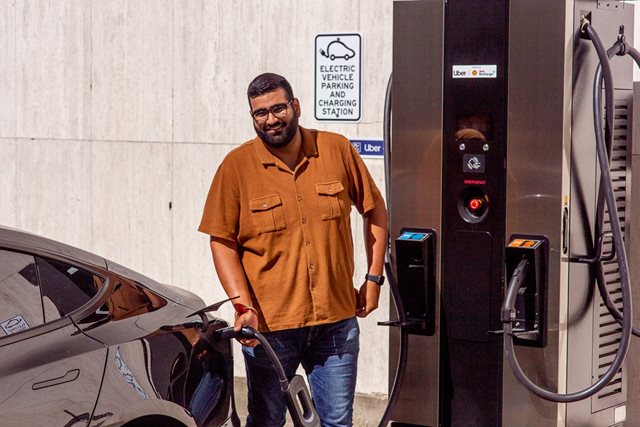
Toronto’s ability to meet its electric vehicle (EV) targets is crucial—not just for hitting climate goals, but for tapping into a fast-growing global market. As the EV revolution accelerates, governments at all levels are making substantial investments in EV and battery manufacturing, adjusting policies to encourage private investment in the supply chain, and streamlining EV charging installation. The region faces a clear risk-reward scenario: failure to act quickly could result in missed opportunities, while embracing the shift positions Toronto to reap significant economic and environmental benefits.
Locally, the City of Toronto’s Environment and Climate Division just outlined an Approach to Public Electric Vehicle Charging to 2030, which proposes a suite of measures meant to ensure that Toronto’s ambitious EV goals of 5% of all registered vehicles to be EVs by 2025 and 30% by 2030 are met with sufficient public charging.
To be sure, Toronto needs to rapidly increase EV adoption rates if it wants to meet its targets. Currently, EVs remain at a low share of all registered vehicles in Toronto at just 2.8% – just marginally lower than the Canadian average of 3% in 2022.
The slow uptake can be attributed to consumer doubts about EVs – including the availability of charging infrastructure. For example, 60% of Canadian consumers who said they will not consider an EV for their next vehicle cited a lack of charging station availability. However, as Ian Klesmer, The Atmospheric Fund’s Director of Strategy and Grants, said in an interview with the Toronto Region Board of Trade: “Cities should strive to create a balanced ecosystem where private enterprises are incentivized to contribute, ensuring sustainability and scalability of charging infrastructure without overly burdening municipal budgets.”
One solution is to ensure that residential and commercial buildings are EV-ready – which refers to a building’s parking spots having access to electrical outlets that can readily connect to an EV charger. While this type of retrofit may not be a problem for a single detached home, multi-unit residential buildings (MURBs) and workplaces require more creative solutions and higher upfront investment to offer charging to tenants, condo owners, and workers.
Home charging is the least costly and the most convenient way to charge EVs and it reduces the total government investment and public land needed for infrastructure, while allowing utilities to create a more responsive energy grid.
By 2026, it is estimated that 21 million households globally will want to use at-home charging for their EVs, up from 2 million in 2021, and 60% of EV drivers say that charging at their workplace is a must-have feature or key factor in choosing to purchase an EV. This represents a vast opportunity for MURB owners and employers to add a much sought-after amenity for tenants and workers.
While all new buildings in Toronto are required to be EV-ready, the City’s older stock of buildings doesn’t typically have the infrastructure that would allow easy installation of a charger. With a 42% share of all residential units in Toronto located in MURBs, the lack of private charging stations in older buildings becomes a major roadblock to EV adoption.
The Board’s recent Banking on Green Playbook offers key lessons for building owners looking to finance EV-ready retrofit projects.
- Derisking Investments: Securing public capital and leveraging government programs, such as the federal ZEVIP, can significantly mitigate financial risks and encourage private investment. Building owners should align EV readiness projects with government funding criteria to secure public funding and incentivize private investors to enter the space.
- Integrating Emerging Technologies: Building owners should be aware of the different levels of EV chargers and the varying degrees of EV-readiness. Each building or project has its unique characteristics, and owners should develop a comprehensive strategy that most effectively suits their conditions and needs while considering what technologies to implement.
- Leveraging Charging-as-a-Service (CaaS): This model allows individual EV owners or building owners to install chargers at little or no upfront cost to reduce the financial burden while operators could offer more flexible and lower-risk EV chargers and recoup the cost over time through service charges. Such collaborations can provide valuable insights and access to the latest innovations.
- Aggregating Projects: Larger, more comprehensive EV charging retrofits are more advantageous and less costly over the long run, rather than smaller piecemeal retrofits. Furthermore, building owners could aggregate projects across multiple buildings to reduce transaction costs and streamline operational processes.
By taking the right approach now, private investors can complement the public charging infrastructure buildout to support the EV transition. A robust charging infrastructure at public stations, at home, and at work would help increase EV adoption across the Toronto region and leverage the economic benefits of this growing market while contributing to the City’s net zero targets.
-

Jeremy Piamonte
Manager, Policy
Jeremy is a public policy professional with more than eight years of experience in non-profits across a variety of sectors and has held roles at organizations like AGE-WELL, Interactive Ontario, and the Ottawa Regional Cancer Foundation. He is a graduate of the Munk School of Global Affairs and Public Policy, where he earned his Master of Public Policy.